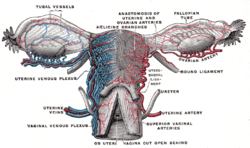Ovary facts for kids
Quick facts for kids Ovary |
|
|---|---|
 |
|
| Blood supply of the human female reproductive organs. The left ovary is the oval shaped structure visible above the label "ovarian arteries". | |
| Latin | ovarium |
| System | Female reproductive system |
| Artery | ovarian artery, uterine artery |
| Vein | ovarian vein |
| Nerve | ovarian plexus |
| Lymph | Paraaortic lymph node |
Ovaries are important organs found in female organisms. They are a key part of the reproductive system. This system is needed for reproduction, which is how living things make new life.
Most animals with backbones, called vertebrates, have ovaries. Usually, animals have two ovaries. However, birds often have only one working ovary. Snakes are a bit different, having one ovary located in front of the other. Ovaries in females are similar to testicles in males.
What are Ovaries?
Ovaries are shaped like eggs. They are usually about 3 cm long, 1.5 cm wide, and 1.5 cm thick. You can find them on the side walls inside the pelvis, which is the lower part of your body.
Each ovary is connected to a Fallopian tube. These tubes are like pathways. Usually, the ovaries take turns releasing eggs, with one egg released each month.
What Do Ovaries Do?
Ovaries have two main jobs:
- They make female sex hormones. These hormones cause changes in the body during puberty.
- They produce ova, which are also called "egg cells." These are the female cells needed for sexual reproduction.
The Menstrual Cycle
During a process called menstruation, an ovum (egg cell) is released from one of the ovaries. This egg then travels into one of the Fallopian tubes. If the egg meets with a sperm cell there, it can be fertilized.
Females are born with a certain number of eggs in their ovaries. When the ovaries stop releasing eggs, this is the start of menopause. During menopause, the body stops making female hormones.
See also
 In Spanish: Ovario para niños
In Spanish: Ovario para niños

